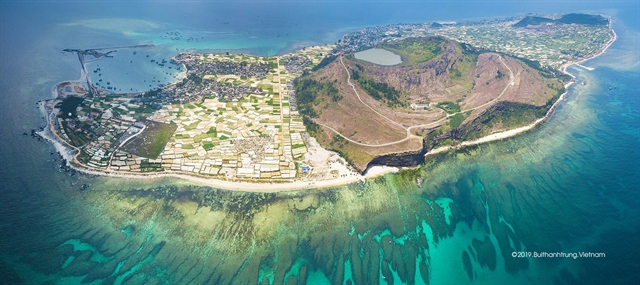
An overview of Lý Sơn Island, off the coast of Quảng Ngãi Province. An area of 4,600sq.km on nine districts has applied for Global Geo-Park recognition by UNESCO. VNS Photo Bùi Thanh Trung
QUẢNG NGÃI — The Lý Sơn-Sa Huỳnh Geo-Park has been listed in the dossier for UNESCO recognition, and the organisation can send an evaluation mission in 2020, general secretary of the Global Geoparks Network and chairperson of the UNESCO Global Geoparks Council, Guy Martini, confirmed in an email on Tuesday.
According to the management board of the Lý Sơn-Sa Huỳnh Geo-Park, the dossier was sent last November for official recognition by UNESCO, and an expert team will be assigned to evaluate the value of the Lý Sơn-Sa Huỳnh Geo-Park, but the plan has been delayed by the COVID-19 pandemic.
Director of Quảng Ngãi Province’s Department of Culture, Sports and Tourism, Nguyễn Minh Trí, said the park is the only candidate dossier from Việt Nam that had been sent to UNESCO.
Many pieces of scientific and geological research on the Lý Sơn-Sa Huỳnh terrain and cultural value were reported at the international conference last year, contributing to the dossier before it was submitted to UNESCO for Global Geo-Park recognition.
Experts from the Việt Nam Institute of Geo-sciences and Mineral Resources said it takes five to seven years to complete a dossier for geo-park recognition, and about seven parks in the world are approved by UNESCO each year. Meanwhile, the park will be evaluated by UNESCO every four years.
Top Vietnamese archaeologists, geologists, volcano researchers and historians agreed that the Lý Sơn Islands, 30km off the coast of Quảng Ngãi Province, were formed by ancient volcanoes that existed more than 25 million years ago.
An area of 4,600sq.km, including more than 2,000sq.km of sea, covering nine districts and islands, has been included in the area for global geo-park recognition.
The recognition of Lý Sơn-Sa Huỳnh as a Global Geo-Park would promote the unique culture, rich biodiversity and extinct volcanoes around Lý Sơn Islands, according to Trí.
Jars of the Sa Huỳnh Culture (1000 BC - AD 200) and stela of Chăm people were found in the coastal Sa Huỳnh area.
Preparatory work has been revved up by the province in finalising procedures for official recognition of the park.
Việt Nam has two global geoparks recognised by UNESCO – Đồng Văn Karst Plateau in the northern province of Hà Giang (in 2010) and Cao Bằng Geopark (2018). — VNS
OVietnam